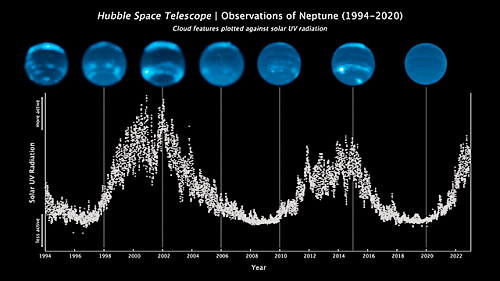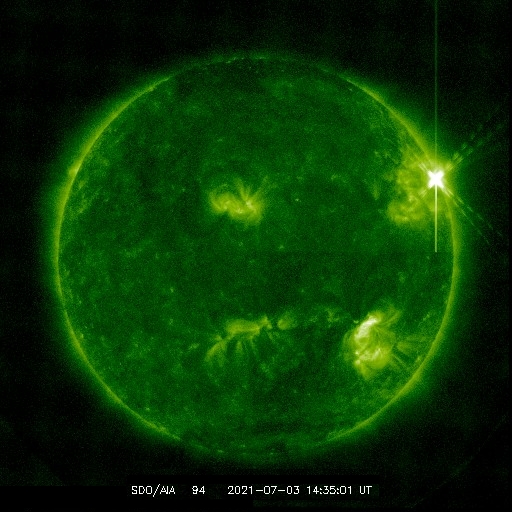Scientists: Neptune’s clouds appear to ebb and grow in conjunction with sunspot cycle

Scientists have now discovered what appears to be a link between the coming and going of clouds on Neptune to the Sun’s 11-year-long sunspot cycle, despite Neptune receiving only 1/900th the sunlight of the Earth.
To monitor the evolution of Neptune’s appearance, Chavez and her team analyzed images taken from 1994 to 2022 using Keck Observatory’s second generation Near-Infrared Camera (NIRC2) paired with its adaptive optics system (since 2002), as well as observations from Lick Observatory (2018-2019) and the Hubble Space Telescope (since 1994). In recent years the Keck Observatory observations have been complemented by images taken as part of Keck Observatory’s Twilight Observing Program and by Hubble Space Telescope images taken as part of the Outer Planet Atmospheres Legacy (OPAL) program.
The data revealed an intriguing pattern between changes in Neptune’s cloud cover and the solar cycle – the period when the Sun’s magnetic field flips every 11 years, causing levels of solar radiation to fluctuate. When the Sun emits more intense ultraviolet (UV) light, specifically the strong hydrogen Lyman-alpha emission, more clouds appear on Neptune about two years later. The team further found a positive correlation between the number of clouds and the ice giant’s brightness from the sunlight reflecting off it.
“These remarkable data give us the strongest evidence yet that Neptune’s cloud cover correlates with the Sun’s cycle,” said de Pater. “Our findings support the theory that the Sun’s UV rays, when strong enough, may be triggering a photochemical reaction that produces Neptune’s clouds.”
The graph to the right shows the correlation between the clouds and the sunspot cycle. The paper is available here.
This conclusion remains uncertain because of the overall sparseness of the data. Yet, it is intriguing, and also underlines the importance of the Sun on the Earth’s climate. If the solar cycle can impact Neptune’s climate so significantly from 2.8 billion miles away, it certainly must have a major impact on the Earth’s climate at only 100 million miles distance.

Scientists have now discovered what appears to be a link between the coming and going of clouds on Neptune to the Sun’s 11-year-long sunspot cycle, despite Neptune receiving only 1/900th the sunlight of the Earth.
To monitor the evolution of Neptune’s appearance, Chavez and her team analyzed images taken from 1994 to 2022 using Keck Observatory’s second generation Near-Infrared Camera (NIRC2) paired with its adaptive optics system (since 2002), as well as observations from Lick Observatory (2018-2019) and the Hubble Space Telescope (since 1994). In recent years the Keck Observatory observations have been complemented by images taken as part of Keck Observatory’s Twilight Observing Program and by Hubble Space Telescope images taken as part of the Outer Planet Atmospheres Legacy (OPAL) program.
The data revealed an intriguing pattern between changes in Neptune’s cloud cover and the solar cycle – the period when the Sun’s magnetic field flips every 11 years, causing levels of solar radiation to fluctuate. When the Sun emits more intense ultraviolet (UV) light, specifically the strong hydrogen Lyman-alpha emission, more clouds appear on Neptune about two years later. The team further found a positive correlation between the number of clouds and the ice giant’s brightness from the sunlight reflecting off it.
“These remarkable data give us the strongest evidence yet that Neptune’s cloud cover correlates with the Sun’s cycle,” said de Pater. “Our findings support the theory that the Sun’s UV rays, when strong enough, may be triggering a photochemical reaction that produces Neptune’s clouds.”
The graph to the right shows the correlation between the clouds and the sunspot cycle. The paper is available here.
This conclusion remains uncertain because of the overall sparseness of the data. Yet, it is intriguing, and also underlines the importance of the Sun on the Earth’s climate. If the solar cycle can impact Neptune’s climate so significantly from 2.8 billion miles away, it certainly must have a major impact on the Earth’s climate at only 100 million miles distance.

